Review for Red Dwarf Series 7 (Three Discs) (UK)
Introduction
For six years, Red Dwarf just seemed to go from strength to strength, with each new series pushing the limits of the space-sci-fi-sitcom genre. The stories got sharper, the comedy got funnier, the production values kept on improving, and the fans grew more and more devoted to the show. Series 6 might have had a few issues in my opinion, but it also had some great stories, and the Emmy Award winning Gunmen of the Apocalypse episode. It also had a rather fiendish cliff-hanger that had the cast going the way of Blake’s Seven. Regardless of the terminal final episode of series 6, fans would have been justified in expecting series 7 in short order.
That wasn’t to be. While fan devotion was never as fervent, behind the scenes there were changes going on, not least of which was that the gestalt entity behind Red Dwarf, Grant Naylor, had finally fissioned into its constituent parts, and the part that was Rob Grant had decided to leave the show. That left Doug Naylor to handle the writing and producing duties himself. It’s no wonder then that the seventh series would take four years to come to our screens. Today, in Red Dwarf terms that seems like a wink of the eye, but back in 1997, it felt like coming to an oasis in a desert. Four years was also a long time in television, and the new series would have an upgraded feel. The video quality would have a filmic style applied in post-production, while the stories would have something of a more dramatic edge to the comedy. The better visuals meant that the studio audience would have to be ditched however, but the schedule would now allow for eight episodes in a series instead of six. There were bigger changes to come as the series unfolded, not least in the cast. Fans were left wondering, not only if Red Dwarf could thrive without Rob Grant, but could Red Dwarf survive without Arnold Judas Rimmer?
3 million years in deep space, Dave Lister, the last human in the universe is trying to make his way back to Earth, along with a hologram of his dead bunkmate Arnold Rimmer, a creature evolved from the ship’s cat, and the service android Kryten. They should be on the mining ship Red Dwarf, along with the ship’s computer Holly, but Lister forgot where he parked it, and it’s been pinched. Now the intrepid threesome, plus Rimmer are trying to track it down in Starbug.
The eight episodes of Red Dwarf Series 7 are presented on two discs, with a whole extra disc devoted to bonus features.
1. Tikka To Ride
Lister tries to recap what happened at the end of the previous episode, but the talk about temporal paradoxes and causality keeps making the camera explode. The bottom line is that all the cross-dimensional weirdness has done something strange to the innards of Starbug, not least of which is the loss of all their curry supplies. Lister is bereft, distraught enough to contemplate time travel again despite its previously experienced consequences. He only wants to go back to an Indian Restaurant in the 22nd Century and make a few hundred orders. They wind up in a certain book depository in Dallas, 1963, where Lister bumps into a guy with a rifle at a window.
2. Stoke Me a Clipper
Ace Rimmer is back, interrupting Lister’s quality time in the AR suite, as he wears out the groinal attachment again. But still, what a guy! But the fact of the matter is that Ace is here to see the one man who loathes him the most... himself. Or rather this universe’s failed version of Ace, one Arnold Rimmer, the loser, the coward, the abject snivelling git, the jumped up, would-be authoritarian with delusions of adequacy. Ace wants him to be a hero. Good luck with that!
3. Ouroboros
One mystery has stayed with Dave Lister all his life, that of his origins. His parents apparently left him in a cardboard box, under a pool table in a Liverpool pub, so indecisive they couldn’t even choose a name, writing Our Rob or Ross on the side. The truth is set to be revealed when Starbug encounters a thing in space so weird that Cat can’t even decide if it’s wibbly or swirly. On the other side lies a parallel universe, a universe where Dave Lister died and was brought back as a hologram, and where Kristine Kochanski survived in stasis, the last human in that universe. She has a favour to ask this universe’s Dave Lister.
4. Duct Soup
On the bright side, Dave Lister’s dream girl is now a member of Starbug’s crew. For Kochanski though, bumming around the universe aboard a dilapidated ship, searching for Red Dwarf, with an idiot, a slob, and a psychotic android, is a bit of a step down in her circumstances. It gets worse when the cooling breaks down, and the plumbing next to her quarters starts hanunga-ing all night, with the odd squalookle. But then the power fails altogether, the doors lock, and the ship winds up heading towards a nearby sun.
5. Blue
Life hasn’t changed much on Starbug. Kochanski is still looking for a way back to her universe, and Lister keeps managing to find a way to screw things up for her. At the same time, Kryten keeps getting jealous, and Kochanski keeps getting annoyed with him. But then, Lister starts getting melancholic, he starts thinking about all the fun times he had with Rimmer. This calls for drastic measures!
6. Beyond a Joke
It’s the anniversary of Kryten’s rescue from the Nova 5, and to celebrate, he’s cooked up something that isn’t space weevil. But then Kochanski went and invited the boys to Jane Austen World in the AR suite to broaden their sense and sensibilities. That’s almost the last straw for Kryten who goes into full gooseberry mode. The actual last straw, the straw that detonated the android’s head, is when Lister asks for an inappropriate condiment at the dinner table. So now the Starbuggers have to deal with an untrustworthy simulant for a new set of Kryten heads.
7. Epideme
A space iceberg offers the chance to replenish Starbug’s water supplies, but trouble lies at the heart of this chunk of frozen water, namely the Starship Leviathan. There’s actually a life-form aboard, one of Lister’s ex-girlfriends is frozen in ice. At least that’s how it looks at first. They aren’t expecting a zombie to thaw out and infect Lister. The actual life form is a smart and rather annoying virus that has been waiting around for 3 million years for a new victim. Now Lister’s only chance is to outsmart a virus.
8. Nanarchy
It’s hard getting used to living with just one arm, especially when you’re bouncing between Kryten’s mollycoddling, and Kochanski’s tough love. The latest in cybernetic technology isn’t all that proficient either. So when Kochanski suggests using Kryten’s nanobots to essentially reconstruct Lister’s arm, it seems like a good idea. The only problem is that Kryten’s nanobots mutinied and jumped droid several thousand years previously, back when they were still on Red Dwarf. There’s nothing left to do but to backtrack their course and try and find them. They certainly aren’t expecting to find Red Dwarf as well!
Picture
Red Dwarf Series 7 gets a 4:3 transfer as you would expect on this DVD release, and the aspect ratio problems for series 6 are just a memory. For Series 7, the production values shot up, mostly by ditching the studio audience, allotting more time for setting up and lighting shots. There is also a filmic look applied to the footage in post-production, so all in all, the lighting, production design, sets, models and costumes have never looked as good (There is one scene at the end of episode 8 which hasn’t had the process applied, and looks like old fashioned video though). The advent of CGI effects doesn’t do the show any justice though. From 1997, they really do look primitive now, and stand out in stark contrast to the model shots, which have dated a lot better. The transfer onto this DVD isn’t great either, as while you can get video to look filmic in post production, you can’t get away from that video source. So while the show does look sharper and you get the impression of greater detail, the underlying image is still of a lower resolution. You’ll see that fine detail and edges are prone to more aliasing and moiré than you’d normally get with DVD.
Sound
The sole audio track is a DD 2.0 Stereo affair which once again reflects the television of the period. The all-important dialogue is clear throughout, and subtitles are provided for the show if you need them as well as for all the extras on disc 3. Unfortunately there are no subtitles for the audio commentaries.
Extras
Red Dwarf Series 7’s three discs are presented in the much loathed stack pack, only the top disc is easily accessible, and if you want another disc, there is a whole lot of disc juggling and potential for scratching involved. Inside the front of the case, you’ll find a sixteen page collector’s booklet with a list of disc contents, although Easter Eggs are just alluded to, rather than listed in detail. There is an overview of the seventh series, and each episode gets a page worth of making of. There are also items of note and points of trivia, and finally a chapter listing.
Discs 1 and 2 present the episodes with an animated menu.
There are alternate versions for some of the episodes, Tikka to Ride (extended version 37:15), Ouroboros (32:43), and Duct Soup (33:30). All three have extended versions, without a laugh track and with extra scenes. Tikka to Ride also has DVD exclusive Remastered versions, both broadcast and extended, with far more accomplished digital effects scenes. Once you see the episode this way, you’ll never watch the original versions again.
There are cast commentaries on all eight episodes although only on the extended versions of Tikka to Ride, Ouroboros, and Duct Soup, as Danny-John Jules, and Chris Barrie get together with Robert Llewellyn and Craig Charles to talk about the shows. From episode three onwards, Chloe Annett also joins the commentaries, and Chris Barrie departs after episode 6, while Norman Lovett (Holly) returns for episode 8. When the shows get funny, don’t be surprised if they wind up watching the gags with you instead of talking. They are still great fun to listen to, recorded as they are after sufficient time for critical appraisal to sink in, with some less than diplomatic anecdotes. The episode 6 commentary is interesting in that Robert Llewellyn co-wrote that episode, so he has a dual perspective to share.
Disc 1 also has an extra called Identity Within, lasting 44 minutes. It’s the lost episode of Red Dwarf, dropped for budget reasons, and replaced with the Duct Soup bottle show. Chris Barrie takes his audiobook experience and performs the script, against storyboards for the story. It’s a shame that this wasn’t made, as it addresses the one unexplored aspect of Red Dwarf, The Cat. There are no Cat episodes, no look at his character and the Cat culture since season 1. This episode takes a bit of classic Star Trek with Amok Time, gives Cat the same malady as Spock, namely he’ll die if he doesn’t get laid, and this sends the Starbuggers off looking for a lady Cat. It was interesting to see that long term Cat commitments turned out just the way I expected.
Disc 2 offers a couple of fan films, presented by Doug Naylor and offering home grown looks behind the scenes of the ever-elusive Red Dwarf movie, and another monster rampaging through Red Dwarf’s corridors. In all this segment lasts 18 minutes.
The bulk of the extras are on disc 3, beginning of course with the ever elusive Easter Eggs. Be diligent and you might find Chloe Annett’s audition reel, and a movie style trailer for Red Dwarf, voice-over-ed by Epideme himself.
The big making of retrospective is there of course, and with eight episodes to discuss, this time it runs to 89 minutes. You can play all of course, or you can watch the Introduction, and each episode bit separately. There is a lot of talk about the changes for Season 7, the departure of Chris Barrie, the arrival of Chloe Annett, the absence of a studio audience, bureaucracy getting in the way of the special effects, and of course the biggest change of them all, the departure of Rob Grant from the show, a big reason why there was such a gap between Seasons 6 and 7.
Everything else is in the Bonus Materials.
In Behind the Scenes, you’ll find the Robert Llewellyn Video Diary, which lasts just 8 minutes, and is prefaced with a disclaimer that it isn’t much of a diary. You’ll find some behind the scenes candidness of the Jane Austen world explosion, and the final day of shooting on Duct Soup. You’ll also find a 5½ minute excerpt from a BBC programme called How Do They Do That? which goes behind the scenes of the Red Dwarf Model Workshop.
The Technically Speaking featurette appears to be mislabelled, as it plays a Burning Rubber featurette instead, offering 2½ minutes of Feeder’s Buck Rogers backing the Red Dwarf crew messing about in all manner of vehicles, real and imaginary.
The Raw FX footage this time has truly entered the CG age, and is consequently split into 3 sections, Model Shots (21 minutes) several of which weren’t used, BBC CGI (5 minutes) and Chris Weale CGI (5 minutes). The latter were created as last minute saves for certain episodes which by that point had diverged from the model footage.
There are 10½ minutes of Smeg Ups, and 43½ minutes of deleted scenes from all eight episodes.
As usual there are the music cues from Series 7, although because of the production issues, many of them were dropped for library pieces in the final edit. This DVD is the first place to hear those themes.
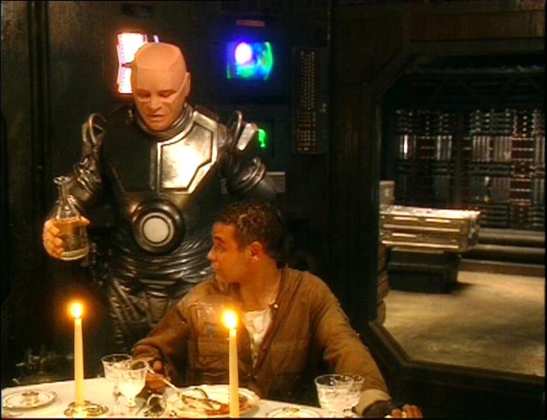
Son of Cliché offers two more excerpts of the Dave Hollins Space Cadet radio sketches, which served as inspiration for Red Dwarf.
The Stills Gallery is packed with Production Shots, Behind the Scenes images, Instant Snapshots and Designs and Covers.
Finally there is a 30 second trailer for the series, and the Kryten Intros to the Smeg Ups and Extended episodes on the original videotape release.
Conclusion
Why couldn’t it all have been like Tikka to Ride? I remember that protracted wait for Series 7 of Red Dwarf, and there I was, poised in front of the TV, ready for my favourite sci-fi space comedy again, and the first show hit it out of the park. I was for a moment convinced that this was my favourite Red Dwarf episode of them all, brilliant, hilarious, and a great concept episode. On top of that, the production values blew me away; all of a sudden we were getting a mini-movie instead of a TV sitcom. The penny should have dropped that weekend, when the BBC broadcast the extended edition of the episode, without a laugh track (as is presented on these discs). Suddenly I wasn’t guffawing as much as I had a few days previously.
It wasn’t even Stoke Me a Clipper that set me on my heels, although I certainly wasn’t impressed with another Ace Rimmer episode, never my favourite character, and surely the departure of Chris Barrie should have boded ill. The fact that Rimmer would show up in cameos in two subsequent episodes was amelioration in that respect. Ouroboros too was a really nice concept episode, and one which added to the mythology of Red Dwarf in an appealing if twisted way. But it was Ouroboros that set in motion the new dynamic of the show by introducing nu-Kochanski to the cast, a replacement for Rimmer. After Ouroboros everything changed, and not for the better. It wasn’t until Duct Soup that I realised that Red Dwarf had lost its magic for me.
Now, after all these years finally watching the show again, I realise that my opinion hasn’t changed. The episodes still disappoint me, and I still compare the show unfavourably to what has come before. I don’t loathe the show however. Time had allowed a resentment to build up that had unfairly condemned these episodes to the nostalgia trash heap. Coming to them again now, I see that there are moments to be appreciated, and to be fair the shows tick along well enough, hit a few high points along the way, provide some entertainment, and generally leave me smirking at the end of half an hour. They aren’t classic Dwarf though.
Problem one is the lack of a studio audience. A natural reaction to a joke and an actor’s ability to adapt his delivery to take into account a laugh is a big deal, and filming it without an audience doesn’t allow the comedy to be honed in the same way. The laugh track was recorded by showing the completed episodes to an audience, and you will hear laughter over punch-lines and feeds, and on occasion at wholly inappropriate moments. I don’t think that Lister tapping a video camera on the side at the start of Tikka to Ride warranted a chuckle. But still, a laugh track recorded after the fact is better than no laugh track at all. This isn’t M*A*S*H which works better without intrusive laughter. A little audience reaction allows for a vicarious communal reaction to the show. Recorded laughter does help key the viewer in, especially when it’s applied moderately and carefully.
Try watching the extended episodes, recorded without laughter to see the difference, and all of a sudden the episodes are mirth-free zones. I manage the occasional smirk, but the belly laughs have dried up. Also it’s surprisingly obvious when the actors leave a gap after delivering a punchline in anticipation of a laugh. The pregnant pause after any of the Cat’s zingers is painful to watch.
The second problem is, well Kochanski. There was no way that they’d get Clare Grogan as a full time member of the cast. Besides, that Kochanski is Lister’s dream girl, his reason for existing, the vain hope that they might one day get back together. That Kochanski is ‘perfect’, and perfection in a comedy just doesn’t work. It would kill the story. Instead we get an alternate universe Kochanski, one who is more akin to Rimmer when it comes to neuroses and professionalism (with the caveat that she can back up the professionalism with actual skill). Chloe Annett is good in the role, and certainly slots well into the cast, bouncing off Lister with some sparky moments. The problem is that her arrival so alters the dynamic of the group, that for me, Cat and Lister almost become supporting players in the Kryten and Kochanski show. In Ouroboros, Kochanski’s neuroses and Kryten’s jealousy were funny. But by Duct Soup, this was already getting old. And that character dynamic dominated the episodes until the end of the series.
For me, the third disappointment is the shift from sitcom to comedy drama. It wasn’t what I was expecting from Red Dwarf, and I don’t feel that it carries it off awfully well. The episodes now feel disjointed and uneven at times, very consciously comedy bits and drama bits in sequence, and by the time we get to Blue and Beyond a Joke, I’m just waiting for the funny bits to come along.
Duct Soup was conceived as a bottle show at the last minute as a replacement for the budget draining, missing Cat episode (see extras), but Blue seems as just as much a bottle show, even though it has some off-ship scenes, the return of Rimmer, and plenty of flashbacks. It feels like a bottle show because of its aimlessness. It’s really about exploring and dealing with Lister’s angst following the departure of Rimmer, and as such seems to wallow in self-reference. It feels maudlin and slow, and I find that it isn’t until the final scene that I remember to laugh. The Rimmer Song is enough of a laugh to make it worth waiting for, but I still do not look fondly on the episode as a whole. Beyond a Joke too fails to ignite any appreciative laughter in me, feeling very much like a mish-mash of ideas, rather than a coherent story. Once again I’m looking forward to that bit which I like the most, and feel like I’m trudging through the rest. Here the bit I like is Jane Austen World. I remember that Star Trek, particularly Voyager lost its way in later seasons when whole episodes would be set in the holodeck. It’s similarly telling that most of the funny that happens in Red Dwarf series 7 happens in the AR suite.
Epideme is an episode where the comedy is almost subsumed by the drama, with Lister’s battle with the smart virus not exactly inspiring chuckles. Around this point, Red Dwarf starts getting dark in its subject matter, and while black comedy can be funny, that’s usually because a show starts off that way. Red Dwarf becomes dark late in its run, and that jars with what I’m used to. Besides, it had already done the sentient diseases far better and with far more impact in Confidence and Paranoia. The only saving grace to Epideme is in that it sets up Nanarchy, which sees the hunt for Red Dwarf come to its conclusion after two seasons. There’s a point to the episode, finding the nanobots that will rebuild Lister’s arm, there’s humour to the show with Lister coming to terms with the loss of his arm, and given differing treatment from Kryten and Kochanski, and Cat reveals a new string to his comedy bow, with a great line in tactlessness. The episode is pacy, punchy and above all funny, and when Holly shows up, it almost looks like my Red Dwarf again. The final scene is a great punchline, but unfortunately when Series 8 shows up, instead of ignoring it as they would have previously, they try and explain it, although that is the least of Series 8’s problems. Series 7 too has its problems, most notably the lines on Kryten’s head, and Lister’s impeccable long-johns (not a single curry stain!) but it is watchable, certainly more so than I recall.
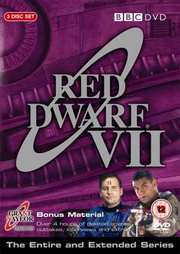
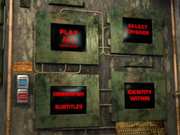
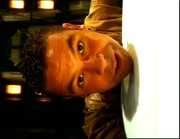
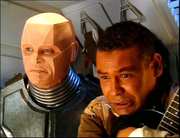
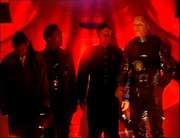
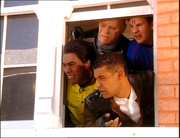
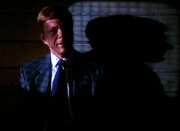
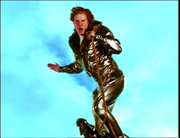
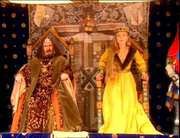
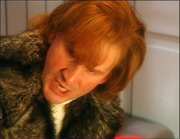
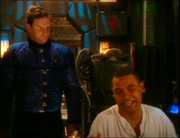
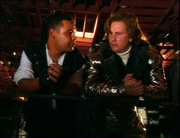
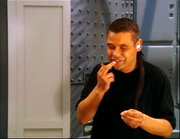
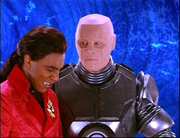
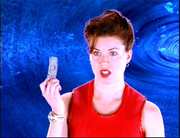
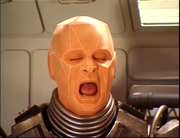
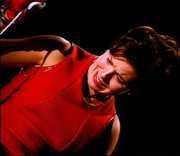
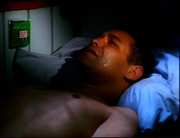
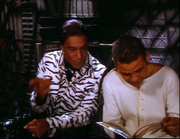
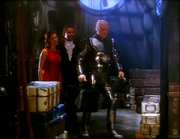
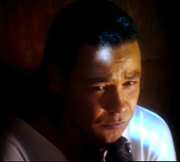
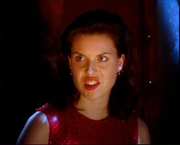

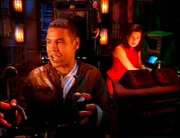
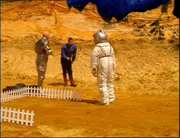
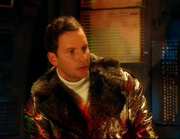
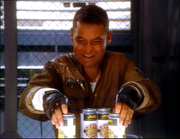


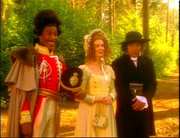
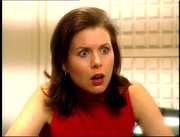
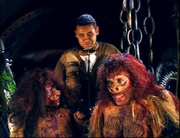
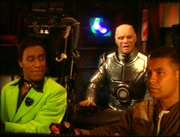
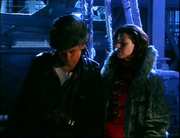
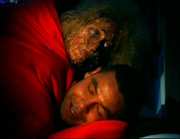
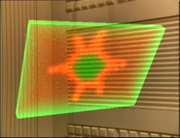
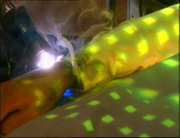
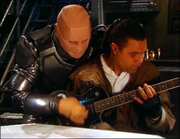
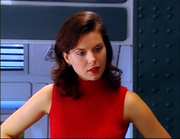
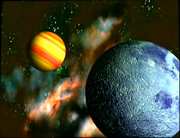
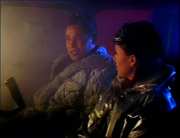
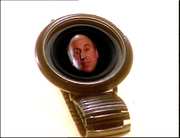







































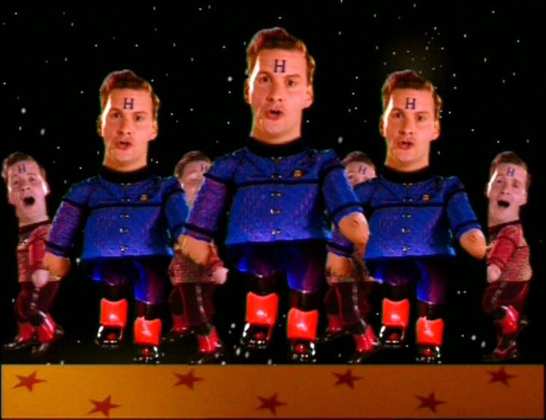





















Your Opinions and Comments
Be the first to post a comment!